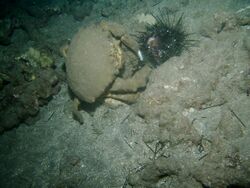Biology:Dromiacea
| Dromiacea | |
|---|---|

| |
| Dromia dormia (Dromioidea: Dromiidae) feeding on a sea urchin | |
| Scientific classification | |
| Domain: | Eukaryota |
| Kingdom: | Animalia |
| Phylum: | Arthropoda |
| Class: | Malacostraca |
| Order: | Decapoda |
| Suborder: | Pleocyemata |
| Infraorder: | Brachyura |
| Section: | Dromiacea De Haan, 1833 |
| Superfamilies | |
| |
Dromiacea is a group of crabs, ranked as a section. It contains 240 extant and nearly 300 extinct species.[1] Dromiacea is the most basal grouping of Brachyura crabs, diverging the earliest in the evolutionary history, around the Late Triassic or Early Jurassic. Below is a cladogram showing Dromiacea's placement within Brachyura: [2] [3]
| Brachyura |
| ||||||||||||||||||||||||
The larvae of Dromiacea resemble those of the Anomura more closely than those of other crabs.[citation needed] This may simply reflect their basal position in the crab phylogeny. The superfamily Eocarcinoidea, containing Eocarcinus and Platykotta, was previously considered to be a member of the Dromiacea, but has since been transferred to the Anomura.[4]
The fossil record of Dromiacea reaches back at least as far as the Jurassic,[5] and, if Imocaris is indeed a member, into the Carboniferous.[6]
Dromiacea primarily consists of two groups of superfamilies - Dromioidea and Homoloidea. See the below cladogram:[2]
| Dromiacea |
| ||||||||||||||||||
Recent studies have found that some of the families may not be monophyletic, but rather paraphyletic.[2]
- The Dromioidea family Dromiidae may be paraphyletic with respect to Dynomenidae
- The Homoloidea family Homolidae is paraphyletic with respect to Latreilliidae
References
- ↑ Sammy De Grave et al. (2009). "A classification of living and fossil genera of decapod crustaceans". Raffles Bulletin of Zoology Suppl. 21: 1–109. Archived from the original on 2011-06-06. https://web.archive.org/web/20110606064728/http://rmbr.nus.edu.sg/rbz/biblio/s21/s21rbz1-109.pdf.
- ↑ 2.0 2.1 2.2 Ling Ming Tsang; Christoph D. Schubart; Shane T. Ahyong; Joelle C.Y. Lai; Eugene Y.C. Au; Tin-Yam Chan; Peter K.L. Ng; Ka Hou Chu (2014). "Evolutionary History of True Crabs (Crustacea: Decapoda: Brachyura) and the Origin of Freshwater Crabs". Molecular Biology and Evolution (Oxford University Press) 31 (5): 1173–1187. doi:10.1093/molbev/msu068.
- ↑ Wolfe, Joanna M.; Breinholt, Jesse W.; Crandall, Keith A.; Lemmon, Alan R.; Lemmon, Emily Moriarty; Timm, Laura E.; Siddall, Mark E.; Bracken-Grissom, Heather D. (24 April 2019). "A phylogenomic framework, evolutionary timeline and genomic resources for comparative studies of decapod crustaceans". Proceedings of the Royal Society B 286 (1901). doi:10.1098/rspb.2019.0079. PMID 31014217. PMC 6501934. https://royalsocietypublishing.org/doi/10.1098/rspb.2019.0079.
- ↑ Jérôme Chablais; Rodney M. Feldmann; Carrie E. Schweitzer (2011). "A new Triassic decapod, Platykotta akaina, from the Arabian shelf of the northern United Arab Emirates: earliest occurrence of the Anomura" (PDF). Paläontologische Zeitschrift 85: 93–102. doi:10.1007/s12542-010-0080-y. http://decapoda.nhm.org/pdfs/31744/31744.pdf.
- ↑ J. W. Wägele. "On the influence of fishes on the evolution of benthic crustaceans". Journal of Zoological Systematics and Evolutionary Research 27 (4): 297–309. doi:10.1111/j.1439-0469.1989.tb00352.x.
- ↑ Frederick Schram & Royal Mapes (1984). "Imocaris tuberculata, n. gen., n. sp. (Crustacea: Decapoda) from the upper Mississippian Imo Formation, Arkansas". Transactions of the San Diego Society of Natural History 20 (11): 165–168.
Wikidata ☰ Q2441028 entry
 |

